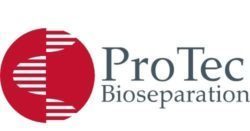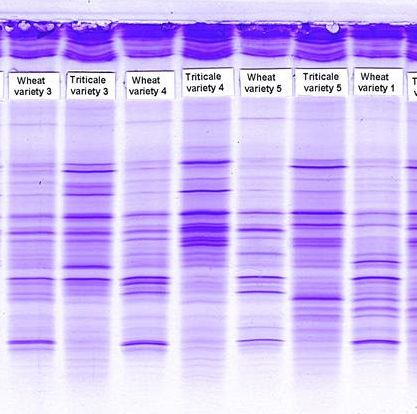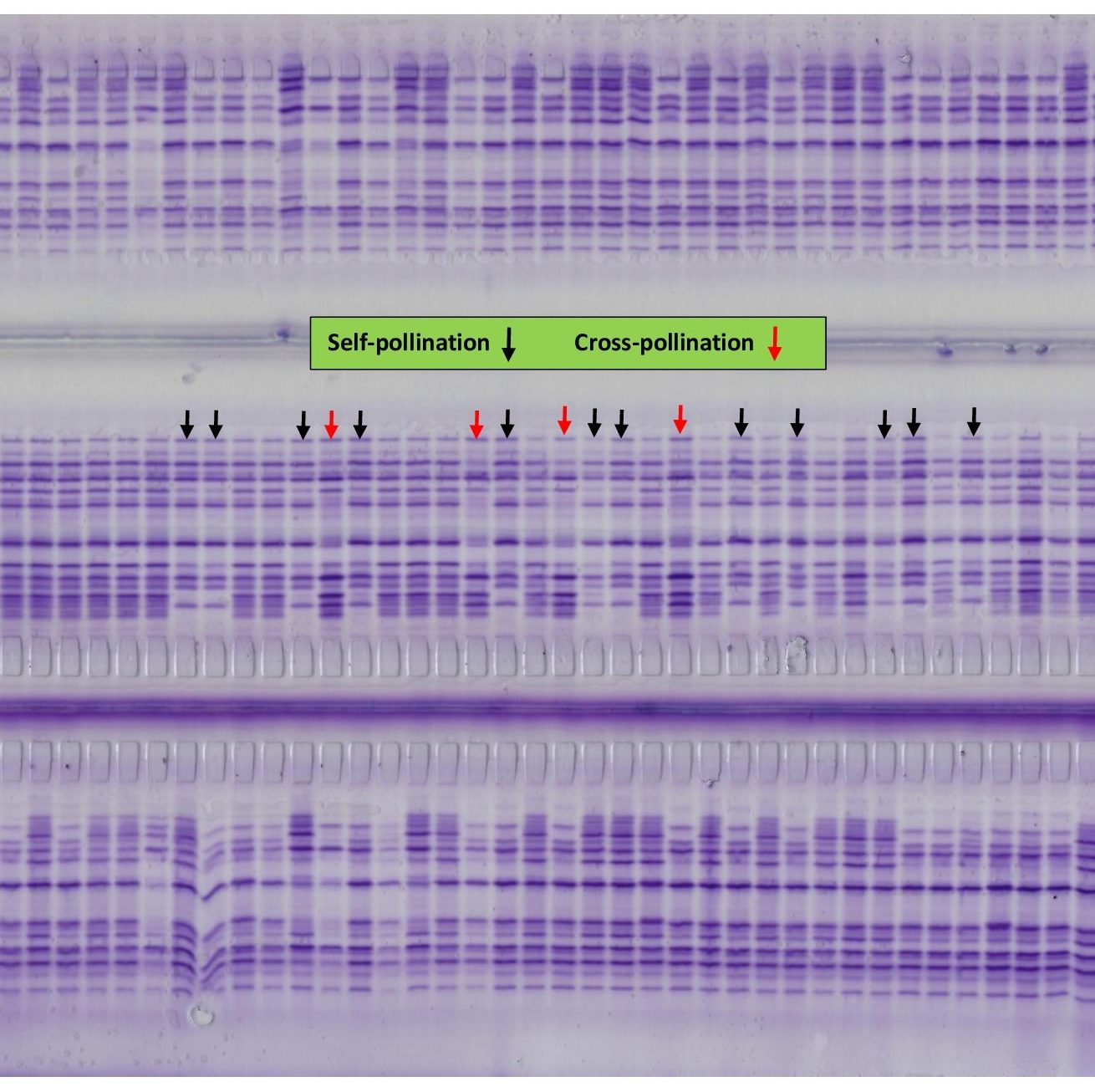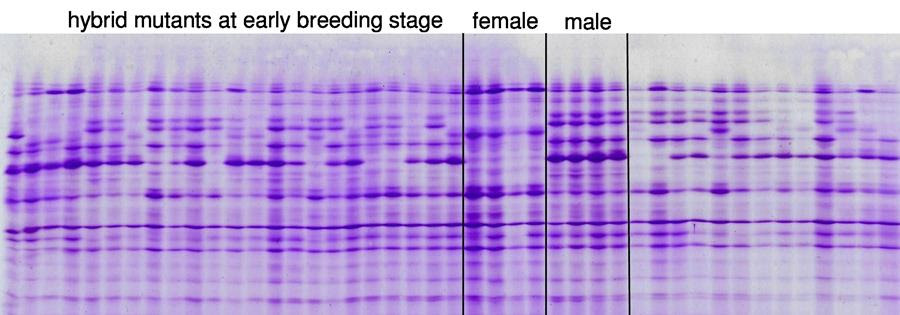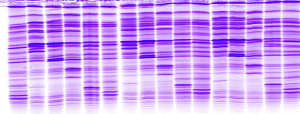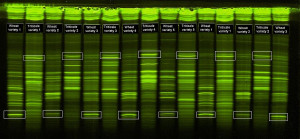Protein versus DNA
or
„Why kill a fly with a sledgehammer ?“
Newsletter 12 / Wheat (Triticum) – Upgrade
We have given the optimised IEF technique its own name, because the results achieved with the ProTec IEF ProPhyl Air GelSystem stand out so positively from those obtained with the standard method (Acrylamide) that there can be no comparison
ProTec Bioseparation
presents the new
IEF ProPhyl Air System
Method: horizontal double isoelectric focusing
Carried out with SepalytesTM on Gel-StickTM (polyester sheets).
Proteins stained with water-soluble Violet 17 (C.I. 42650).
Wheat varieties (cut out from the gel above) measured in cm.
If you need information please contact m.demharter@protec-biosep.de.
Workshops can be arranged (free of charge).
Within Germany, training courses in your laboratory are possible.
Newsletter 11 / Wheat (Triticum)
Variety testing of wheat
Method: horizontal isoelectric focusing
Carried out with Sepalytes (carrier ampholytes) on GelStick (polyester sheets)
Proteins stained with water soluble Violet 17 (C.I. 42650)
The 10 wheat varieties (120 samples) were applied in sets of 4. In one set, we deliberately applied a ‚foreign‘ variety (i.e. 3 + 1 foreign) to demonstrate how easy it is to detect foreign samples in the finished result
(see middle row 14th sample from left).
Wheat varieties (cut out from the gel above)
If you need information please contact
m.demharter@protec-biosep.de
Workshops can be arranged !
Newsletter 10 / Maize (Zea mays)
Genetic purity determination of Maize seeds
(no coleoptile required)
Isoenzymes to be determined : Alcohol dehydrogenase using a new Sepalyte™.
Methode: isoelectric focusing
Newsletter 9 / Wheat
Wheat (Triticum)
Genetic purity determination of Wheat seeds.
Isoenzymes to be determined : Malate dehydrogenase (MDH) using a new Sepalyte™ wheat carrier ampholyte.
Method: Isoelectric focusing
Newsletter 8 / Maize
Zea mays
Genetic purity determination of Maize seeds (no coleoptile required).
Isoenzymes to be determined : Malate dehydrogenase (MDH) using a new Sepalyte™ maize carrier ampholyte.
154 single seeds on a GelStick™ polyester sheet.
Newsletter 7
Luffa Gourd (Cucurbitaceae)
Hybrid purity determination of LUFFA GOURD (seeds) using a hybrid variety F1 with corresponding parental lines
Isoenzyme to be determined : Malate dehydrogenase (MDH) using Sepalyte™ LF pH 5-8 carrier ampholyte.
Newsletter 6
Sunflower (Helianthus annuus)
Hybrid purity determination of SUNFLOWER (seeds) using a Sunflower hybrid variety F1 with corresponding parental lines:
Isoenzymes to be determined : Malate dehydrogenase (MDH) using Sepalyte™ SF pH 5-8 carrier ampholyte.
Method: UTLIEF (ultra-thin-layer iso-electric focusing). Gel cast onto a GelStick™ transparent, flexible polyester film (horizontal gel system)
Newsletter 5
Sunflower (Helianthus annuus)
Varietal purity determination of SUNFLOWER proteins (seeds) using Sepalyte™ pH 7-8+
Separation of five SUNFLOWER varieties on one gel (105 seeds), using Sepalyte™ pH 7-8+ carrier ampholyte. Staining : Acid Violet 17 C.I. 42640 (water soluble , needs no organic solvents)
Method: UTLIEF (ultra-thin-layer iso-electric focusing). Gel cast onto a GelStick™ transparent, flexible polyester film (horizontal gel system).
Newsletter 4
Genetic purity testing of MAIZE from SEED ! ( no coleoptile required )

Isoenzyme Malate-Dehydrogenase (MDH) from maize seeds (Hybrid F1 and corresponding parental lines) Rehydrated horizontal IEF acrylamide gel 2 x 52 in-gel wells
A new high-throughput method for genetic purity testing of maize hybrid varieties is presented
The method is based on rapid homogenization of maize seed in a standard 96-wells microplate, followed by isoelectric focusing (horizontal IEF) of the crude homogenate and staining the gel for malate dehydrogenase (MDH) activity.
IEF of the crude homogenates is done using the ProTec MDH Gel Kit comprising highly reproducible rehydrated acrylamide gels ( gels with a thickness of 0,5 mm) Because there are washed before drying, they are free from monomeracrylamid and are non toxic. Gels are polymerized on support polyester films with 2 x 52 in-gel wells that enable quick and easy sample loading using a 12-channel multipipet.
A special IEF ampholyte (Sepalyte™) mixture to reach the proper pH gradient and MDH staining chemicals complete the kit. IEF of MDH from maize seed shows clear and easy to interpret expression of all five maize MDH genes. The phenotypic variability of MDH is governed by several alleles per MDH gene which gives rise to more than 1000 possible combinations of MDH bands.
The high genetic discriminative power of the MDH system makes it possible to develop a hybrid purity test based on a difference in the MDH pattern for the majority of maize hybrids.

Genetic identity testing ( MDH ) can be done at the same time with a very high chance to detect genetic impurities other than inbreds, such as those a rising from undesired pollination or undesired mixing of seed batches.
This new method makes it possible to carry out a maize genetic purity test in 1 day from seed. With the ever increasing demand to have genetic purity test results as quick as possible after harvest of the seeds in order to carry out the necessary follow up, this simple and quick method can easily be integrated in a seed quality assurance program.
Benefits and features:
- No need for laborious starch gels electrophoresis
- Results within 1 day (from extraction to IEF electrophoresis to MDH stain)
- Extraction from seed – no need to grow time-consuming seedlings (coleoptile )
- No dealing with messy stains
- 104 samples on a gel
- Free from toxic acrylamide
- Long expiry time of dried acrylamide gels and Sepalyte™ solution
- Flexible application
Newsletter 3
Varietal purity determination of TRITICALE proteins using Sepalyte™ pH 3-6 WHEAT/TRITICALE
Differentiation between WHEAT and TRITICALE
In our tests we found:
a WHEAT-specific protein marker (not present in triticale) at the acid end pI < 4.0
a TRITICALE-specific protein marker (not present in wheat) at the base end pI > 5.0
(alternating left to right: five varieties of WHEAT and five of TRITICALE)
More tests will be done to verify the result !
Original Acid violet 17 stained gel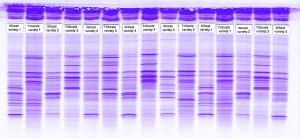
Separation of five TRITICALE varieties and five WHEAT varieties on one gel, using Sepalyte™ pH 3-6 WHEAT/TRITICALE carrier ampholyte.
(alternating left to right: five varieties of WHEAT and five of TRITICALE)
Staining : Acid Violet 17 C.I. 42640 (water soluble , needs no organic solvents)
Method: UTLIEF (ultra-thin-layer iso-electric focusing).
Gel cast onto a GelStick™ transparent, flexible polyester film (horizontal gel system).
We used the following protocol for Isoelectric focusing gel preparation.
Newsletter 2
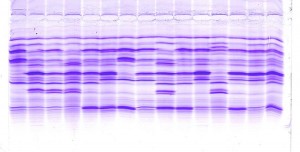 NEW – Varietal purity determination of WHEAT using Sepalyte™ pH 3-6 wheat
NEW – Varietal purity determination of WHEAT using Sepalyte™ pH 3-6 wheat
Separation of 15 wheat varieties using our new Sepalyte™ pH 3-6 WHEAT carrier ampholyte.
Method: UTLIEF (ultra-thin-layer iso-electric focusing). Gel cast onto a GelStick™ transparent, flexible polyester film (horizontal gel system).
ProTec Bioseparation shows you a simple way to implement effective quality assurance. We offer you a comprehensive solution package, from advice on the ideal equipment setup, sample preparation, gel preparation down to a fully customised and detailed protocol.
If you don’t have any IEF equipment and chemicals, and want to test the quality of the new Sepalyte™ WHEAT, you can simply send us some anonymised wheat samples for a first cost free analytical trial. Practical workshops can be arranged on demand.
Newsletter 1
Hybrid purity of MAIZE using Sepalyte™ pH 2-9 seed mix
(Protein separation executed according to ISTA Rules Chapter 8)
ProTec Bioseparation specialises in the production of high quality carrier ampholytes for isoelectric focusing (IEF) and custom-designed kits for the analysis of seed purity such as our Sepalytes pH 2-9. Over 20 years of experience in the manufacture of carrier ampholytes and sustained efforts to optimise IEF separation performance have led to the product we now call Sepalyte™.
If you don’t have any IEF equipment and chemicals, and want to test the quality of the new Sepalyte™ WHEAT, you can simply send us some anonymised wheat samples for a first cost-free analytical trial. Practical workshops can be arranged on demand.
Feel free to suggest crops (cereals, vegetables..) for the next NEWSLETTER.
m.demharter@protec-biosep.de
